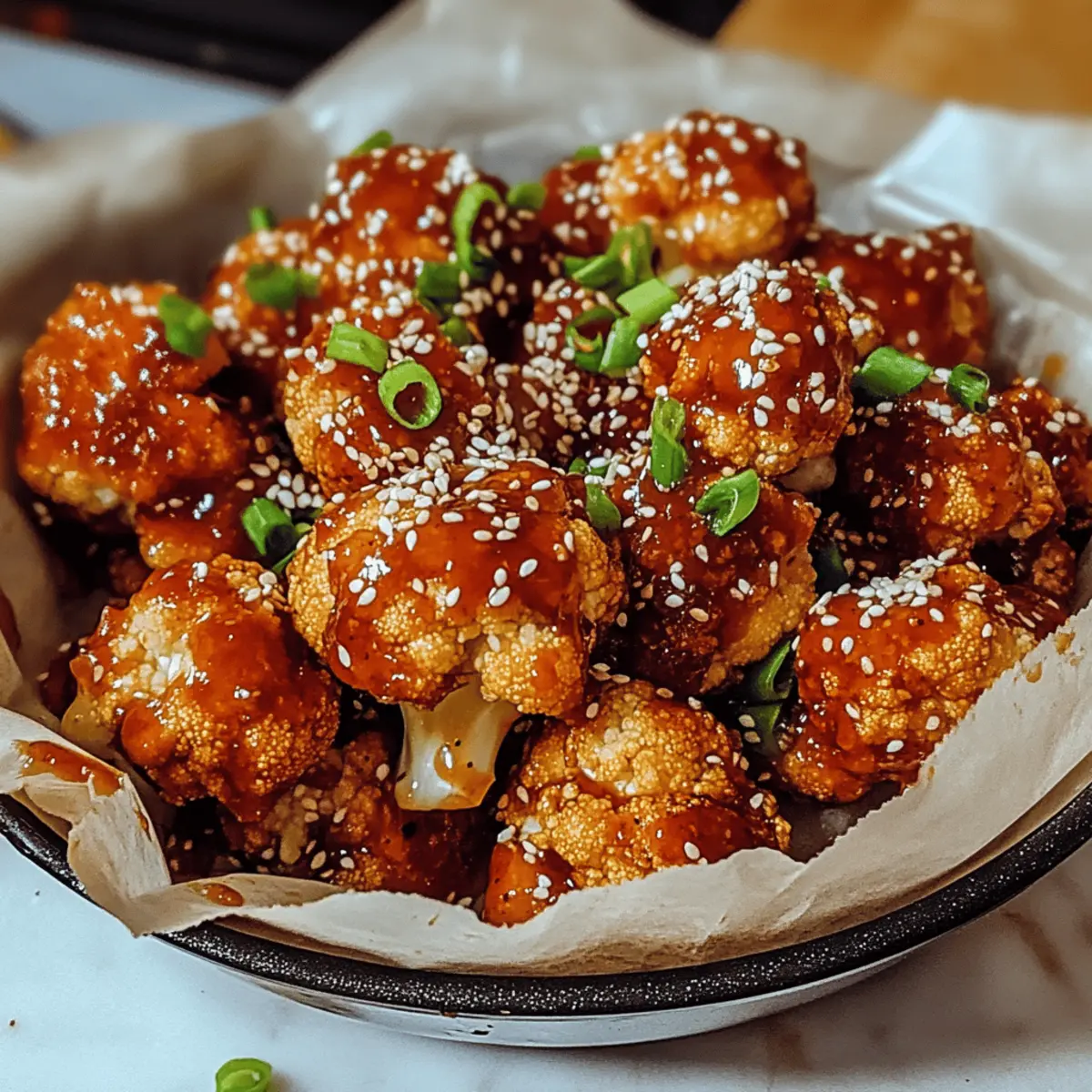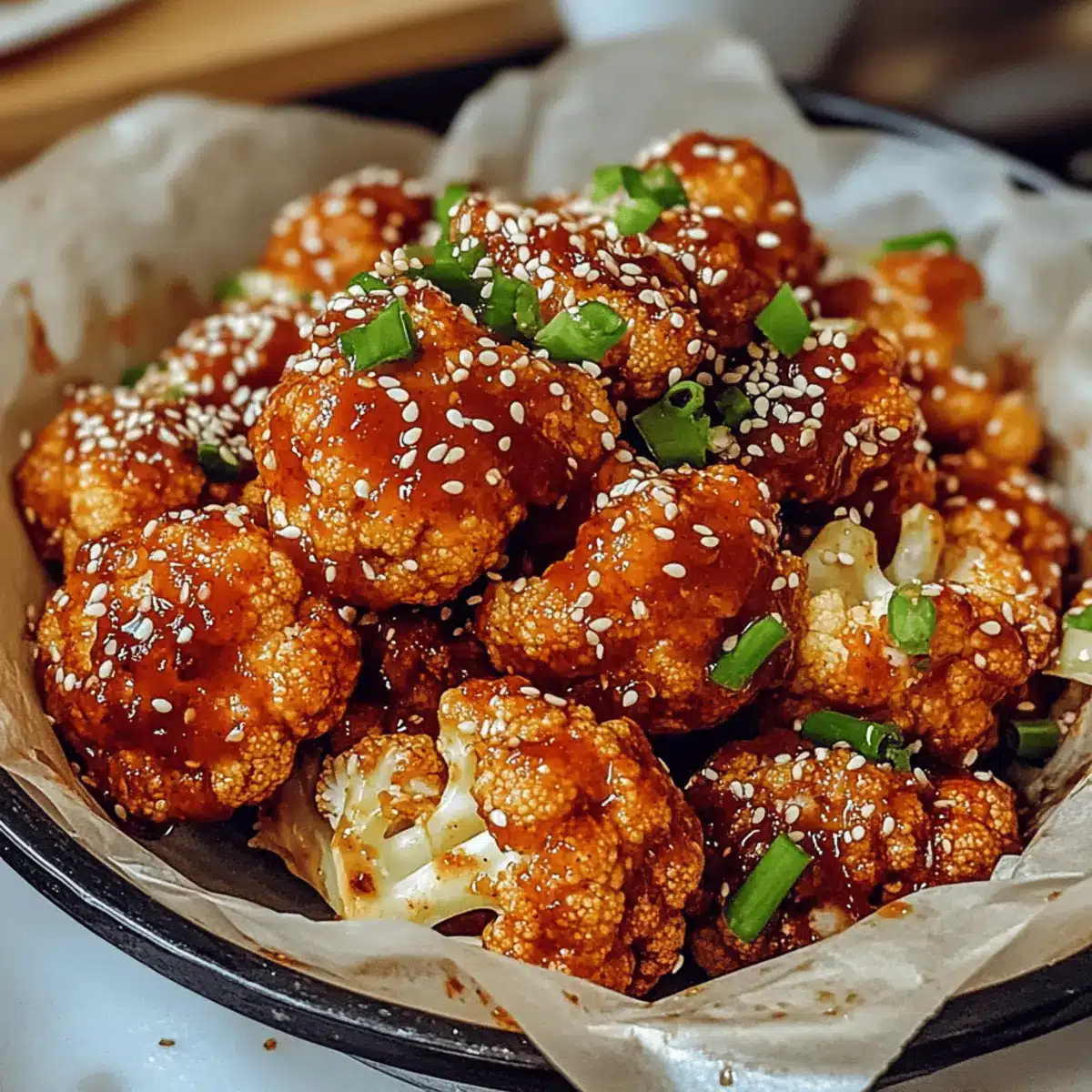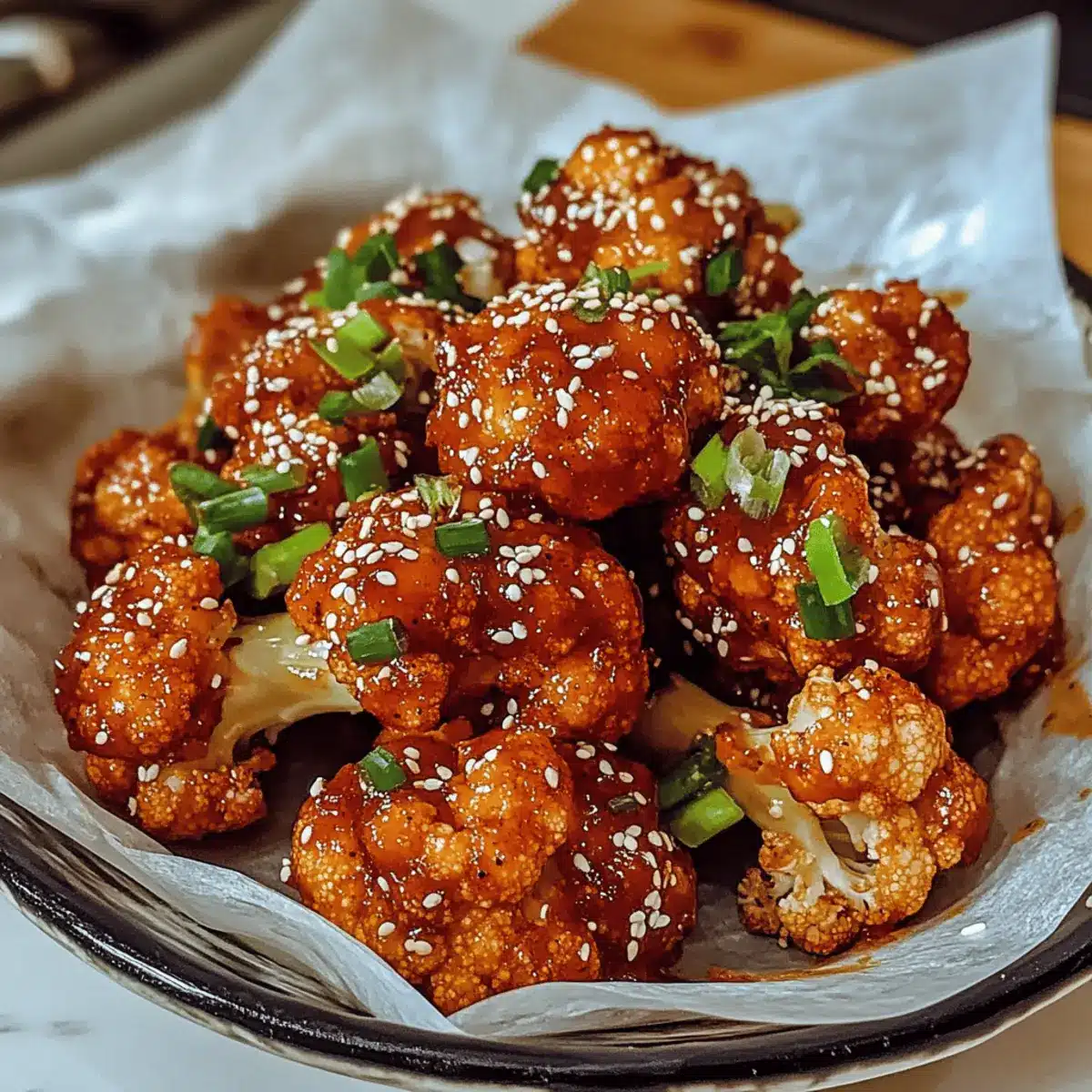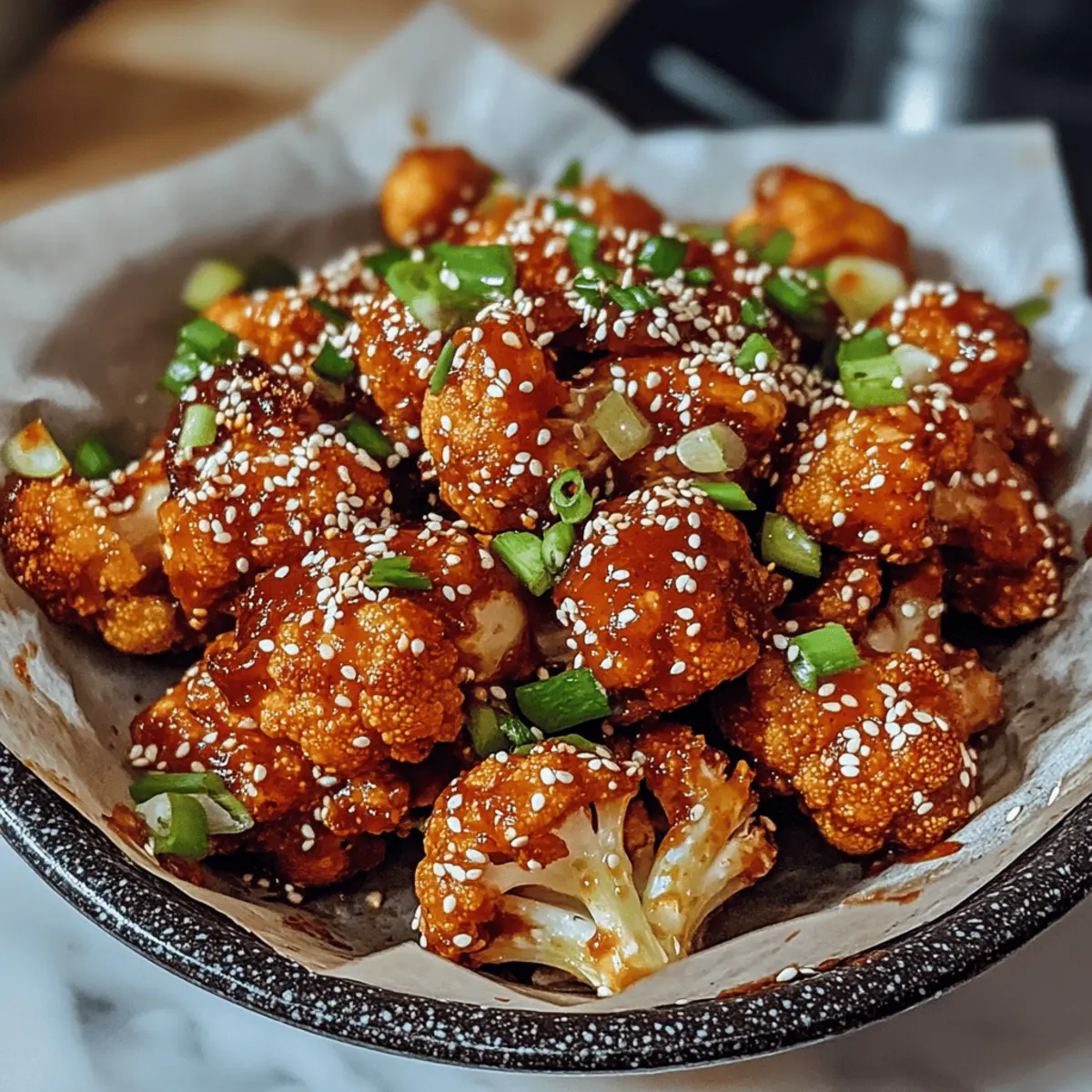The aroma filled my kitchen like a vibrant street market in Seoul, whisking me away to a place where the flavors burst with life. This Korean Baked Cauliflower is my delightful twist on comfort food, perfect for anyone seeking a satisfying, plant-based dish. The star ingredient, cauliflower, is transformed into a crispy masterpiece coated in a fiery gochujang sauce that strikes the ideal balance between sweet and spicy. Not only is this recipe gluten-free, but it also brings a healthy upgrade to your dining table, ensuring you won’t miss those greasy takeout nights. Perfect as an appetizer, tantalizing side, or even a standout main dish, this cauliflower creation is sure to impress. Curious about how to infuse your meals with this bold, Korean-inspired flavor? Let’s dive in!

What Makes This Cauliflower Recipe Special?
Bold Flavors: The gochujang sauce infuses the cauliflower with a delightful blend of sweet and spicy, elevating it beyond typical vegetable dishes.
Crowd-Pleasing Appeal: Serve this dish at your next gathering, and watch it disappear quickly—it’s an instant favorite for guests!
Healthy Indulgence: You’re indulging in crispy goodness without the guilt—this recipe is plant-based and gluten-free!
Versatile Serving: Pair it with cooked rice or quinoa for a wholesome meal, or serve as a vibrant appetizer for your next party.
Easy Preparation: With just a few simple ingredients and minimal prep time, you can whip up this dish in no time, making it a perfect go-to recipe for busy weeknights or entertaining.
For more delicious ideas, check out my recipes for Korean BBQ Steak or Pumpkin Apple Baked Oatmeal.
Korean Baked Cauliflower Ingredients
For the Cauliflower
- Cauliflower – The main ingredient that provides a hearty, plant-based base for our dish.
For the Sauce
- Gochujang – This is the main flavoring agent that adds a sweet and spicy kick to the sauce; a must for authentic taste!
- Soy Sauce – Enhances umami flavors and helps achieve that beautiful caramelization during baking.
- Honey – Balances the spice with sweetness; for a vegan option, substitute with maple syrup.
- Sesame Oil – Adds richness and a nutty aroma; can be replaced with olive oil if sesame is unavailable.
- Garlic Powder – Provides depth of flavor and enhances the sauce; fresh garlic is a fantastic alternative.
- Salt and Pepper – Essential for seasoning to taste and enhancing overall flavor.
For Garnish
- Sesame Seeds – Sprinkle on top after baking for added texture and visual appeal.
- Green Onions – Chopped green onions offer a fresh, vibrant finish to your dish.
Step‑by‑Step Instructions for Korean Baked Cauliflower
Step 1: Preheat the Oven
Begin by preheating your oven to 425°F (220°C). This elevated temperature will ensure a crispy exterior for your Korean Baked Cauliflower. While the oven heats up, it’s a great time to prepare your baking sheet by lining it with parchment paper to prevent sticking and make cleanup a breeze.
Step 2: Prepare the Cauliflower
Carefully cut the cauliflower into bite-sized florets, aiming for uniform sizes to ensure even cooking. Once you’ve got the florets ready, set them aside in a large bowl. The cauliflower will serve as the hearty base, soaking up all those delicious flavors from the sauce you’re about to make.
Step 3: Make the Sauce
In a separate bowl, whisk together gochujang, soy sauce, honey, sesame oil, garlic powder, and a pinch of salt and pepper. This mixture should be thick yet pourable, with a vibrant color that beckons. Taste the sauce and adjust if necessary; you want that perfect balance of sweet and spicy to coat your cauliflower beautifully.
Step 4: Coat the Cauliflower
Pour the prepared sauce over the cauliflower florets in the bowl. Using your hands or a spatula, toss until each floret is evenly coated with the rich gochujang mixture. This step is crucial for maximizing flavor—every bite should remind you of the boldness of Korean cuisine.
Step 5: Arrange on the Baking Sheet
Transfer the coated cauliflower florets to the lined baking sheet, spreading them out into a single layer. Ensure there’s space between each piece to allow for even roasting. Crowding the pan may lead to steaming rather than crisping, so give them room to breathe and roast perfectly.
Step 6: Bake to Perfection
Place the baking sheet in the preheated oven and bake for 25-30 minutes. Toss the cauliflower halfway through to achieve that desired golden-brown exterior on all sides. You’ll know it’s ready when the florets turn crispy, with a delightful char, and emit an irresistible aroma.
Step 7: Serve and Garnish
Once baked, remove the cauliflower from the oven and let it cool slightly. For an extra touch, sprinkle with sesame seeds and chopped green onions before serving. This Korean Baked Cauliflower can be enjoyed hot as a snack, side dish, or main component of a meal, bringing vibrant flavors to your dinner table.

How to Store and Freeze Korean Baked Cauliflower
Fridge: Store leftover Korean Baked Cauliflower in an airtight container for up to 3 days. This helps maintain its flavor and texture, so you can enjoy it again soon!
Freezer: For longer storage, freeze the cauliflower in a freezer-safe bag or container for up to 2 months. Ensure it’s fully cooled before freezing to preserve quality.
Reheating: Reheat the cauliflower in the oven at 350°F (175°C) for about 10-15 minutes. This will help restore its crispiness, making it just as delicious as when freshly baked.
Serving Tip: Revive any leftover cauliflower by tossing it with a drizzle of fresh gochujang sauce before serving for an extra flavor boost!
Make Ahead Options
These Korean Baked Cauliflower florets are a fantastic option for meal prep enthusiasts! You can prepare the gochujang sauce up to 24 hours in advance and store it in the refrigerator. Additionally, you can cut the cauliflower into florets and refrigerate them separately until ready to use. When you’re prepared to serve, simply toss the cauliflower florets in the sauce for an even coating, spread them on a baking sheet, and bake as directed. This approach not only saves you valuable time on busy weeknights but also ensures that the flavor remains just as bold and delicious. Remember, keeping the sauce and cauliflower separate until baking helps maintain that perfect crispy texture!
Expert Tips for Korean Baked Cauliflower
Even Coating: Ensure each cauliflower floret is evenly coated in sauce for uniform flavor and texture. This step is vital for achieving the best Korean Baked Cauliflower.
Simplicity in Spiciness: Adjust the spice level by varying how much gochujang you use, allowing you to cater to different taste preferences for your guests.
Crispiness Counts: For a crunchier finish, extend the baking time slightly while keeping an eye to avoid burning. Taste testing is key!
Avoid Overcrowding: Use a baking sheet large enough for the cauliflower florets, giving them space to roast evenly rather than steam.
Herb Garnish: Enhance the final dish with fresh herbs like cilantro or parsley alongside sesame seeds for an extra flavorful twist and vibrant presentation.
Korean Baked Cauliflower Variations
Feel free to explore new flavors and textures with these delightful twists on your Korean Baked Cauliflower!
-
Veggie Boost: Add bell peppers or carrots to the baking sheet for extra color and crunch. These vibrant vegetables will not only cheer up your dish but also pack in some nutrients.
-
Milder Flavor: Swap out gochujang for sweet chili sauce if you prefer a less spicy version. This is an easy swap that keeps all the deliciousness while softening the heat!
-
Herb Infusion: Mix in fresh herbs like cilantro or parsley after baking for a bright, fresh lift to your dish. The herbaceous notes will complement the rich flavors beautifully.
-
Crunchy Topping: Top with panko breadcrumbs before baking for a delightful crunch. You can even toast the crumbs with some garlic for an extra flavor punch!
-
Add some Sweetness: Drizzle with additional honey or maple syrup after baking to enhance the sweetness against the spice. This creates a lovely balance that makes each bite more enjoyable.
-
Spicy Up: For an extra kick, sprinkle crushed red pepper flakes or drizzle some jalapeño-infused olive oil before serving. This blend will take your taste experience to another level!
-
Savory Twist: Incorporate tofu or tempeh cubes tossed in the sauce before baking for added protein. This transforms your cauliflower dish into a wholesome meal!
-
Seafood Delight: Pair with shrimp or scallops for a unique surf-and-turf take on this dish. Bake the seafood alongside the cauliflower for a one-pan experience that will wow your guests.
For more vibrant flavors inspired by Korean cuisine, check out my recipes for Korean BBQ Meatballs or the spicy goodness of Korean BBQ Steak. Enjoy your culinary adventures!
What to Serve with Korean Baked Cauliflower?
Elevate your culinary experience by pairing this vibrant dish with complementary sides that enhance its delightful flavors.
-
Steamed Jasmine Rice: The fluffy rice serves as a perfect foundation to soak up the sweet and spicy gochujang sauce, balancing the bold flavors of the cauliflower.
-
Crispy Asian Slaw: A fresh mix of cabbage, carrots, and sesame dressing adds a crunchy texture and zesty finish that contrasts beautifully with the tender cauliflower bites.
-
Spicy Kimchi: Adding a side of this fermented staple not only boosts flavor with its tangy heat but also brings a traditional Korean element to your meal.
-
Sweet Potato Wedges: The natural sweetness from the roasted sweet potatoes complements the spicy notes of the cauliflower, creating a harmonious blend of flavors.
-
Miso Soup: This warm, comforting soup brings umami depth that pairs exquisitely, enhancing the overall dining experience with each sip.
-
Chilled Sparkling Water with Lime: An effervescent drink keeps the meal light while the citrus notes cleanse the palate, making it a refreshing accompaniment to the rich cauliflower dish.
Each of these pairings creates a delightful medley, ensuring your Korean Baked Cauliflower shines as a star at the table!

Korean Baked Cauliflower Recipe FAQs
How do I select the best cauliflower for this recipe?
Absolutely! When choosing cauliflower, look for heads that are firm and compact, without dark spots or blemishes. Fresh cauliflower should have a creamy white color and green leaves; avoid those with yellowing leaves, as they indicate age.
What’s the best way to store leftover Korean Baked Cauliflower?
To keep your leftovers fresh, store them in an airtight container in the refrigerator for up to 3 days. This preserves the flavor and texture. Reheating in the oven is preferable to the microwave, as it helps regain that lovely crispness.
Can I freeze Korean Baked Cauliflower?
Yes, you can freeze it! Allow the baked cauliflower to cool completely, then transfer it to a freezer-safe container or bag. It will stay fresh for up to 2 months. When ready to enjoy, reheat straight from frozen in the oven at 350°F (175°C) for about 15-20 minutes, until heated through.
What if my cauliflower isn’t getting crispy?
Very common! Ensure you’re spread out evenly on the baking sheet and not overcrowding them, which can cause steaming instead of roasting. If you notice that the cauliflower isn’t crisping up, extending the baking time by 5-10 minutes while monitoring closely will help achieve that perfect texture.
Are there any dietary concerns I should be aware of?
Certainly! This recipe is gluten-free and plant-based, making it suitable for a variety of diets. Just be aware of the gochujang, as some brands may contain gluten or preservatives. For those with allergies, always check labels to avoid any unwanted ingredients!
How can I add more flavor or variety to this dish?
Absolutely! For an extra flavor burst, consider adding more veggies like bell peppers or carrots on the baking sheet. Additionally, you can swap the gochujang for a less spicy sauce to suit your taste or top your finished dish with sesame seeds or chopped green onions for added garnish and crunch.

Crispy Korean Baked Cauliflower with Sweet Spicy Gochujang
Ingredients
Equipment
Method
- Preheat the oven to 425°F (220°C).
- Cut cauliflower into bite-sized florets and set aside.
- Whisk together gochujang, soy sauce, honey, sesame oil, garlic powder, salt, and pepper.
- Toss cauliflower florets in the sauce until evenly coated.
- Arrange coated florets on a lined baking sheet.
- Bake for 25-30 minutes, tossing halfway through.
- Sprinkle with sesame seeds and green onions before serving.

Leave a Reply